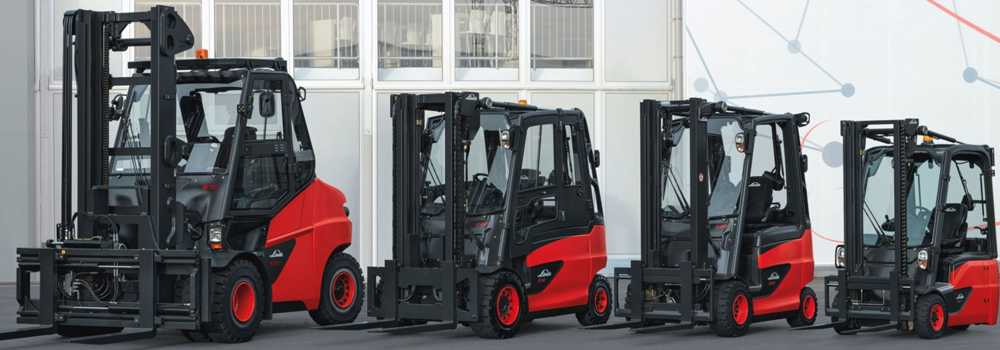If you want to know what must be done daily before using a forklift, then you’ve stopped at the right place. We have a detailed guide on the crucial daily checks and maintenance routines you need to keep your forklifts in top-notch condition. So, let’s dive into the world of forklift inspections.
Why Daily Forklift Inspections Can Save You Time and Trouble
Managing forklifts in the US requires a disciplined approach to consistent maintenance and inspection, ensuring safety is a priority alongside productivity. Forklifts, vital in various industries, can encounter many issues if neglected. Therefore, thorough daily inspections and regular maintenance are critical for any forklift operator.

Lithium-ion forklifts
Carrying out comprehensive inspections isn’t just about upholding on-site safety; it’s also about keeping your fleet of forklift trucks in optimal condition for longer. This proactive approach catches problems before they morph into serious faults, saving you from the headache of unexpected issues or downtime.
Daily Forklift Pre-Operational Checks Are a Must
Before you rev up the engine of that forklift truck, here are some essential checks to perform:
- Engine oil levels: A telltale oil puddle beneath the truck could mean trouble. Keep those oil levels in check to ensure the engine ticks over smoothly. Of course, if you’re operating an electric forklift then you can skip this step (try not to look too smug about it though!)
- Fuel level: Whether it’s an electric or combustion engine, ensuring your power source is well-filled is key to keeping that catalytic converter or battery in fine fettle.
- Look over the dashboard: Dials and warning messages can serve as early indicators of issues. Keep an eye out for those brake indicators, engine sensors, and lights.
Your Daily 10-Point Forklift Inspection Checklist
To keep your reach truck in good health, consider this handy 10-point checklist:
- Check that the lights and indicators are functioning to light the paths and notify others of movement.
- Ensure the fuel and oil levels are adequate if you’re operating a combustion engine forklift truck.
- Give the horn a test – it’s a crucial tool for alerting others and reducing workplace accidents.
- Examine the tyres for adequate inflation and check the treads for wear.
- Check that the steering wheel and column are moving smoothly and aligned properly.
- Inspect the forks for any noticeable damage – they’re used daily, after all!
- Give your workwear a once-over for high visibility and ensure no loose material can get snagged.
- Perform a brake check to ensure they engage quickly and safely.
- Adjust the seat position and mirrors to suit your needs for a safe driving position.
- Be mindful of the truck’s capacity limits to not overload it.
The Visual and Operational Run-Down
When it’s time for your forklift to hit the floor, there are two types of checks to keep in mind:
Visual Inspection:
- Fluids should be at the appropriate levels with no leaks.
- Lights and indicators must be in working order—replace any that have gone kaput.
- Tyres should be free from damage and inflated correctly.
Operational Inspection:
- Test the horn and ensure all alarms are sounding off perfectly.
- Brakes, gears, and hydraulic controls must be responsive and in good working condition.
- Attachments, cables, and chains should be secure and functional.
Remember, these checks are vital to prevent accidents and ensure the longevity of the equipment.
The Importance of Forklift Inspections
Undertaking pre-use safety inspections of powered industrial trucks isn’t just wise – it’s a requirement under various occupational safety standards, like OSHA. These inspections become particularly critical if your forklift is operated on a round-the-clock basis. Identifying any defects and reporting them immediately ensures that the forklift doesn’t become a hazard.
Aside from safety, regular inspections serve to reduce project downtime and improve the potential resale value of the equipment through proper maintenance.
Long-Term Forklift Checks and Balanced Operation
In addition to your daily vigilance, don’t lose sight of long-term maintenance checks:
Minor and Intermediate Maintenance Check-Ups:
- Every 250 hours, focus on things like oil changes, tire inspections, and checking cylinder head bolts.
- At the 500-hour mark, you’ll want to adjust valve clearances, change filters, and test chain lift tension.
Major Maintenance:
- Every 2,000 hours, dive into comprehensive checks involving coolant replacements, belt inspections, and hydraulic oil changes.
A Note on Forklift Safety Operation
Operating a forklift safely is not just about knowing your checks and balances; it’s about awareness and skill. Always ensure your forklift operators are certified and familiar with the specific type of forklift they are handling. Awareness of the work area, adherence to safety protocols, and keeping the forklift clean can go a long way in preventing accidents. Operating forklifts is a responsibility that should be undertaken with utmost care and precision.
Remember, a well-maintained forklift is a productive and safe forklift. Take care, and keep those checks in check!